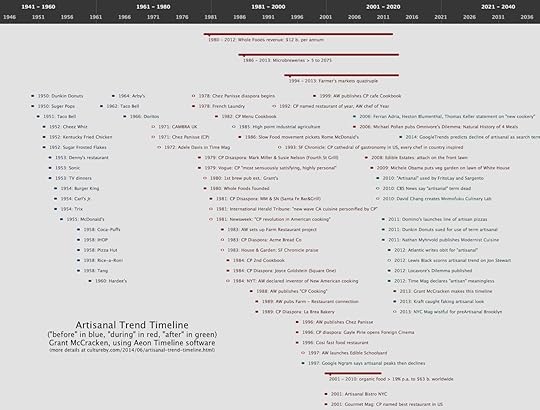Grant McCracken's Blog, page 13
June 18, 2014
Artisanal Trend Timeline
I gave my Culture Camp in London last week. I feel a little like a peddler producing my new array of household cleaners and brushes. “Here’s a lovely notion no planner or strategist should be without!”
Here’s one slide that people seemed to find useful.
(Apologies if WordPress compresses this slide too much. Try clicking on it for a larger view.)
The idea was to show trends in motion. The events picked out in blue represented the pre-artisanal era, the period in which we liked our food fully industrial and the more artificial the better.
(In Camp, we talk about all the machinery perfected for the war effort applied in the late 40s and 50s to food, and the great explosion of prepared food and fast food brands, including of course Tang, that utterly artificial foodstuff endorsed by astronauts!)
Then the reaction, the repudiation, of artisanal food begins with the counter culture and the emergence of the person who was to be the goddess of the new movement, Alice Waters and her restaurant Chez Panisse, the one that was to prove the beachhead of the new movement. Waters and CP brought a new idea into the world and then sent a diaspora of chefs and enthusiasts who went out into the world to colonize it in the name of the artisanal.
And then comes the reaction to the reaction. Those events picked out in green are harbingers of the new, as new innovations and inclinations rise up to propose new approaches to food. This is not to say the artisanal trend will disappear. Some of its transformative effects have changed us forever. But a new perspective will emerge, and it will set in train a great revolution in chefs, restaurants, TV shows, cooking magazines, and food culture generally. And it will change the way we are eating in a decade or so. At this point, all we have are “faint signals.”
As readers of this blog now, I am looking for more sophisticated ways of looking at culture. We need these devices if we are to make sense of the great turbulence of our culture. But I think they also help us clarify culture for clients for whom it is mysterious. I think this Artisanal Trend Timeline is a good way to say, “Ok, here’s the bigger picture. This is why we believe you should be primed to launch product X at moment Y.”
If you are interested in attending the Culture Camp, please let me know at grant27ATgmailDOTcom. The next one will be in New York City possibly in the late summer.
If you want a high rez version of this slide, send me an email at the same address.
June 16, 2014
Secrets of charisma from Iggy Azalea
I came back from London yesterday. As the jet-lag began to lift, I thought:
“What happened in American culture while I was gone?”
First stop, VH1 where I saw this new video from Ariana Grande. Grande is so lovely she makes Audrey Hepburn look like an awkward teenager with problem skin and unfortunate hair.
But watch the video and note the performance by Iggy Azalea who comes in at the 1:50 mark.
Doesn’t Iggy, with roughly a third the video, end up owning it? Somehow, she delivers charisma while Ariana ends up looking quite a lot like Hepburn in some of her lesser roles, lovely but insubstantial.
The secret is I think clear. Iggy doesn’t care if we like her. At 2:22, she does that ”Like, what?” and wrinkles her nose, but that’s the only time she courts our approval. The rest of the time, the attitude is more “aren’t you ever so lucky to be watching this video?”
 Ariana on the other hand flirts with the camera with a steady flow of entreaties and ingratiations. Several gestures are meant to emphasize how little and unthreatening she is. (As if she could be any smaller and less threatening.)
Ariana on the other hand flirts with the camera with a steady flow of entreaties and ingratiations. Several gestures are meant to emphasize how little and unthreatening she is. (As if she could be any smaller and less threatening.)
 While in England, I had a chance to catch up with Peter Collett, a friend from years ago. (Thank you, John Deighton for putting us back in touch.) Peter is perhaps the world’s ranking expert in matters of non verbal behavior and I leave it to him to have a look at the video and this blog, and sort things out for us.
While in England, I had a chance to catch up with Peter Collett, a friend from years ago. (Thank you, John Deighton for putting us back in touch.) Peter is perhaps the world’s ranking expert in matters of non verbal behavior and I leave it to him to have a look at the video and this blog, and sort things out for us.
Watch this space for Peter’s remarks.
Clearly, it’s more than nonverbal behavior. Iggy uses a hip hop idiom where Ariana confines herself to a music from which everything vivid or powerful has been deliberately removed.
As a last note, I found this version of the Iggy Azalea Clueless remake (aka Fancy) online and I was stunned to see how much clearer the audio track is. This is the “explicit” version of the video and I think the means that the “tame” version of the video was created by “graying out” the offensive terms. This technique, versus removing or replacing, is weird and interesting. I think.
June 5, 2014
Oh my god!
 Does anyone know the origins of this exclamation?
Does anyone know the origins of this exclamation?
Does anyone know when it rose to such prominence?
Does anyone know why this phrase (and not some other) is so popular at the moment?
I did a very quick search and came up with this:
Jonathan Quayle Higgins from the TV show “Magnum P.I.” apparently said it a lot.
It also featured in the movie Clueless.
Any other thoughts?
June 4, 2014
Culture Camp London June 13 (and an apology)
 Apologies for the radio silence. I have been running flat out.
Apologies for the radio silence. I have been running flat out.
I just presented some of my work in Washington. I can’t talk about this and it’s just killing me. This anthropologist has never presented in circumstances so exalted. I hope I will some day be free to give you the details. Stay tuned
The work for Netflix continues. And it’s absorbing. And really interesting. On Thursday I’m going to Austin for the ATX conference. I’ll be hosting a panel. Please drop by and day “hi.”
I am also working on the Culture Camp for London. That’s Saturday June 13th.
First, a note of apology. For reasons that are now lost in the mists of time, I chose to describe the camp as something designed for “cultural creatives” and to some English readers this suggested that this course was designed for creatives who make advertising.
My mistake. This course is for students of culture, planners, strategists, innovators and ethnographers. And yes, in the second half we will talk about how we can use your knowledge of culture to make culture.
The First Half: Mapping Culture
The first half of the Camp will review of the big trends reshaping our lives, markets, and culture. We will look at the transformation of house, home, and family, the artisanal revolution in the world of food, what happened to “status” and “cool” as drivers of our culture (specifically, how they got extinguished and what replaces them), the revolution in the way we define women, the rise and role of old media and new.
You know those programs on PBS that shows us the coast line of Scotland from a low flying plane. That’s what the first half is going to be like, American and Western culture as if from a Piper Cub aircraft traveling at 12,000 feet. The whole thing (more or less) laid out before you. We will talk about how you can build your own “radar” to track changes in this culture.
The Second Half: Making Culture
The second half of the Camp is going to be really hands on. It is one thing to know about our culture. It’s another to begin making culture, in the form of design, advertising, innovation, story telling.
As far as I know, there is no handbook that shows what we do when we act as “meaning makers.” And this is a pity, because what the ad person has learned about creating culture in the form of an ad can serve the designer who is creating culture in the form of a brand.
We will talk about cultural arbitrage, and here we will talk about a recent video by Ingrid Michaelson, the comedy by Amy Schumer, the TV of Beau Willimon, the design work of Warby Parker, and the advertising by Carmichael Lynch for Subaru.
We will be talking about the meaning making, the meme making of Old Spice, Pharrell, Volvo, Apple, Oreo, Microsoft and others.
And we will be talking about the new rules of storytelling. TV is effectively become a laboratory for the reinvention of story telling. This gives me a chance to draw on my Netflix work to show how story telling is changing and what the new rules are.
This is a “vista” opportunity, a chance to see the what and the how of culture in a new, more systematic way.
So, please do come join us. Here’s the link.
May 23, 2014
brand runners?
 If the brand is changing, how about branders?
If the brand is changing, how about branders?
I’ve been reading about “show runners” lately, and I thought, “hey, what about “brand runners?”
I’m not saying “let’s invent a new position.” I’m saying, let’s ask marketing people to think about themselves in a new way.
So what is a show runner? The clip is a pretty good evocation of what he or she does.
Scott Collins of the LA Times offers this definition. He calls showrunners “hypenates:”
a curious hybrid of starry-eyed artists and tough-as-nails operational managers. They’re not just writers; they’re not just producers. They hire and fire writers and crew members, develop story lines, write scripts, cast actors, mind budgets and run interference with studio and network bosses. It’s one of the most unusual and demanding, right-brain/left-brain job descriptions in the entertainment world….[S]how runners make – and often create – the shows, and now more than ever, shows are the only things that matter.
Also, see this illuminating clip from a documentary called Showrunners here.
I think a “brand runner” might look something like this. Managing a brand is a task of fearsome complexity, keeping track of all the traditional brand meanings, auditioning all the new ones, speaking to many segments not just a couple, identifying and tracking all the coming trends (both the blue oceans and the black swans), making the brand bold and clear even as it becomes in places delicate and obscure, reaching out to a variety of meaning-makers and organizing and articulating their work, changing the brand architecture strategically, tuning the brand message in real time. Brand running could a lot like show running.
Most of all, the brand runner metaphor suggests that we would work with the brand in a constant but highly variable process. Lots of big thinking. Lots of fine tuning. “Running a brand” seems somehow closer to the present truth than “managing” it. The metaphor assumes that creativity is the first order of business. Out goes the “business as usual” notion that brand management suggests. Brand running would be less about business and more about creativity, and a constant, collaborative creativity at that.
At the Brand and Brand Relationship conference this week, we ended with a panel discussion lead by Susan Fournier and including Aaron Ahuvia, Eric Arnould, Anders Bengtsson, Markus Giesler, and Jonathan Schroeder and yours truly. It’s wrong of me to speak for them….so I will. I believe you could feel a certain pressure of speech or ideation in the room. There were ideas waxing, threatening to overtake our trusted orthodoxies. Or maybe not. I love that moment when you can feel things “melting into air.” And I think they were.
In any case, (new job description or no) perhaps we could think about the brand as something being constantly pitched, green lit, put into production, crafted as an idea and a reality, with scenes, episodes and seasons, hammered out with producers, writers and actors with whom it is being thought and rethought, as it keeps melting into air and precipitating back into the life of the consumer.
For more metaphoric materials, see the Wikipedia entry for showrunners here.
May 22, 2014
May 21, 2014
Brands and Brand Relationships
I did a talk today for Susan Fournier’s Boston University conference called Brands and Brand Relationships.
It was illuminating, forcing me to see things I didn’t know I thought.
I will try to get the slides up for tomorrow. (If anyone knows the most elegant way of getting a Keynote (or Powerpoint) deck onto WordPress, please let me know. Converting them to a YouTube video just feels laborious. Because it is.)
May 20, 2014
Tolerance, now even for liberals!
Here’s an ad from Cadillac called Poolside.
I think Poolside is a nice piece of work and I said so here. I particularly like how provocative it is.
And, my goodness, was it provocative. Writing for the Atlantic, Rebecca Rosen recounts several reactions:
Elizabeth Weiss, writing in the New Yorker, said the character seemed “vaguely sociopathic.” In The Washington Post, Brigid Schulte condemned his celebration of a work culture that, she argued, is driving us to be “sick,” “stressed,” and “stupid.” Adam Gopnik, also in the New Yorker, called it, “the single most obnoxious television ad ever made.”
It looks for a moment that Rosen might withhold from this piling on. But no, in the event, she declares Cadillac man a “crass materialist.”
Is it just the anthropologist in me that find these criticisms distressing? No, I think it’s the liberal.
As I was laboring to say yesterday, liberals are obliged to tolerate even people they don’t much like. Shrug with asperity, if they must, but they are obliged to show even disagreeable parties a certain respect. Or at the very least forgo the scorn
“Vaguely sociopathic”?
A work culture that makes us “sick,” “stressed,” and “stupid”?
“The single most obnoxious television ad ever made”?
We may not like Cadillac man. But if we are liberals, this has nothing to do with it. As J.S. Mill points out, the idea is not that we should like other people. This is, he says, entirely unlikely in any case. The idea is that we respect their right to define themselves as they chose to define themselves. We must tolerate even those we find obnoxious.
Otherwise, mark you, you are not a liberal.
Acknowledgements
Thanks to Eric Nehrlich for spotting Rosen’s essay.
May 19, 2014
Shoulder-shrugging: the durable kind of tolerance
 It is widely noted that Millennials are a tolerant bunch. They accept diversity and the rights of minorities. The younger you are the more likely you are, for instance, to take for granted a gay couple’s right to marry. Tolerance is a demographic wave. It will eventually triumph.
It is widely noted that Millennials are a tolerant bunch. They accept diversity and the rights of minorities. The younger you are the more likely you are, for instance, to take for granted a gay couple’s right to marry. Tolerance is a demographic wave. It will eventually triumph.
This is the outcome of a variety of historical and cultural influences. In the present day, the most effective players perhaps are Hollywood and the elementary-school system. These institutions took on entrenched hostility, racism, anti-semitism, homophobia, and xenophobia. And, mostly, they prevailed. A task of no small difficulty. An accomplishment of some real significance.
But there is, I think, a flaw in the Hollywood-School approach. And it’s the inclination to treat tolerance as an act of generosity, as something that fills the world with the light of human goodness. This approach is designed to show how deeply satisfying is the act of tolerance and in most cases to make us reach for our hankies. Tolerance…is…just…so…beautiful. (Snuffle, snuffle, honk.) We are not only doing the right thing, we are generously compensated for our good behavior.
But consider this second approach to tolerance:
Dutch tolerance was never “nice”. It was, as Shorto remarks, built not on admiration or even celebrating difference, but precisely on indifference, on letting others live their lives regardless of what one might think of their practices and beliefs, as long as they did not interfere with the business of society and of business itself. It was a shoulder-shrugging tolerance.
(This is Philipp Blom in his Times Literary Supplement (April 30) review of a new book by Russell Shorto called Amsterdam: A history of the world’s most liberal city. Little, Brown)
Shoulder-shrugging tolerance may be the more powerful, durable, dependable form of tolerance. And it is one promoted by J.S.Mill. (Though I’ll be damned if I can find the passage in question.) The idea, Mill says, is not that we are supposed to like the people of whom we are tolerant. The liberal idea is that we are supposed to endure even those we find dubious, difficult or repellent.
Forget the self congratulation. Stow the hankies. We are obliged to be tolerant all the time, and not just when it feels good or makes us look good. Real tolerance is not always “nice.”
Now, this might be merely a point of principle were it not for the eruption of a certain illiberality in American culture. Politics have turned into a shouting match. There are no limits to things we are prepared to call one another. Character assignation is the order of the day. And this comes from people who would insist that they are the very souls of liberal toleration.
I will use one example from my own experience. When even well educated, tender-hearted Canadians discover that my wife is American, they let fly with extended rants that drip with a bitter tongued indignation. It doesn’t seem to matter that my wife and I are standing right there. A small but apparently invisible point of courtesy. But what is also missing, and I mean utterly invisible, is the Millean idea that we are obliged to respect even those we dislike. Do these liberals understand liberalism?
And here’s perhaps the oddest twist. Even Millennials, our best and brightest accomplishment in the liberal ascendancy, can be discovered trashing the opposition…even as they insist that they are liberal to the very core. Apparently, Hollywood and the school system missed the “Dutch” part of the story.
We can guess at what happened here. Hollywood of the old fashioned kind sometimes struggled to tell a story unless it had a swelling orchestra in the background. Big emotions, yes. Shrugging, not so much. So “hanky” liberalism was bound to get on the studio “docket” while Dutch liberalism was not.
The same might be true for elementary school. Hanky liberalism is a great story to tell. It makes the teller look so very noble. The “told,” too. Hanky liberalism carries a rhetorical pay load. It says, “embrace this idea and we’ll adorn you in nobility.”
Shrugging liberalism, that’s a less pretty story. But to the extent that it delivers the more durable form of liberalism, it’s the more urgent one.
Acknowledgements
To Wodek Szemberg with whom I was talking about tolerance just a couple of weeks ago in Toronto.
The photo. showing a magnificently elaborate shrug, is an outtake from the Pharrell Williams’ Happy video here.
May 16, 2014
Church, state, and the new rules of marketing

selbst fotografiert
Buzzfeed has leaked an internal report from the New York Times.
I was struck by this passage:
“The very first step … should be a deliberate push to abandon our current metaphors of choice — ‘The Wall’ and ‘Church and State’ — which project an enduring need for division. Increased collaboration, done right, does not present any threat to our values of journalistic independence,” the report says. […]
“It’s the old world where the publisher and the editor work together,” senior editor Sam Sifton, who worked on the cooking project, told the report’s authors. “It’s not lions lying down with lambs. It’s a mutually beneficial, symbiotic relationship.”
I just finished working a project for Netflix and Wired, and I got to see collaboration up close.
Certainly, this project represents a repudiation of the old “church and state” distinction. The “state” called Netflix paid for content that appeared in the “church” called Wired. (And I wrote the “copy.”)
Some people will accept this as the kind of break-through that Jonah Peretti of Buzzfeed has been arguing for for some time. Others will decry it as the invasion of capital into journalism. Still others (AdAge’s Michael Sebastian, to be exact) suggested that this story might give us a glimpse of the future in some of the ways that NYT’s Snowfall did.
But there is an anthropological observation to make, and that is none of us (and by “us,” I mean Netflix, Conde Nast and me) appeared to be looking to make this content shill for the sponsor. More to the point, we were not conflating church and state. If anything we were being at least as fastidious as the old order.
None of us was looking to amp up the pitch. No one said, “Grant, can you dial up the emphasis on Netflix, please.” In fact, the only editorial intervention was the removal of the names of shows that I had used to illustrate the power of the new TV, and this was occasioned by the fact that non-Netflix properties did not want to have their shows appear in a piece sponsored by Netflix.
Why were we being so fastidious? I think there is a simple marketing answer here. Any marketing exercise that shills now actually diminishes the power of the communication. Consumers just dial that stuff out.
We have entered a new era in which viewers, consumers take intelligence and imagination as the necessary condition for their attention. Shilling is clumsy and overbearing. It disqualifies itself.
This is what happens when popular culture, driven by commerce, becomes culture plain and simple. It has to stop acting like a shilling exercise, or suffer the consequences…and these are immediately exclusion from readerly interest.
“Oh, it’s only an ad. Next!”
The new rule of marketing says you can’t buy your way into people’s lives. If you make marketing with scant regard for the way this marketing draws on and contributes to culture, you provoke an instantaneous push back from the consumer.
This must qualify as good news. Even as the “grey lady” (aka NYT) wonders whether she can risk the conflation of church and state, the world of marketing is finding that it is obliged to be fastidious. Whew.
Acknowledgements
Thanks Rick Liebling for the head’s up.





